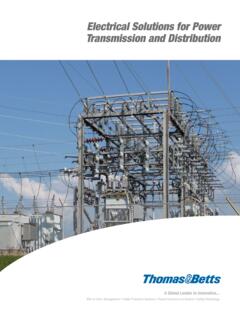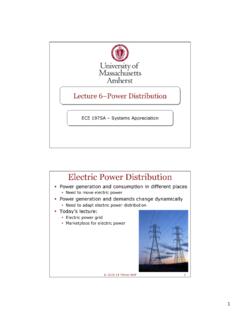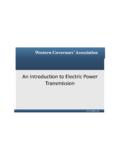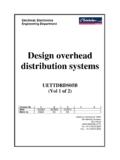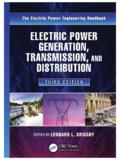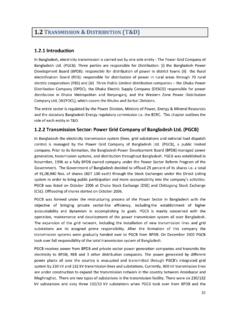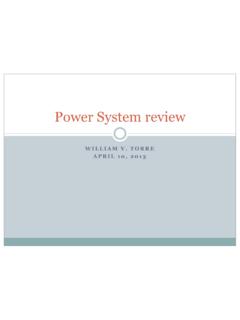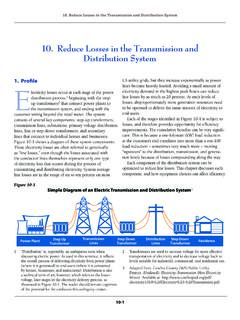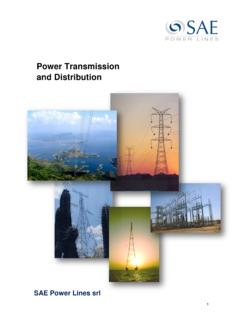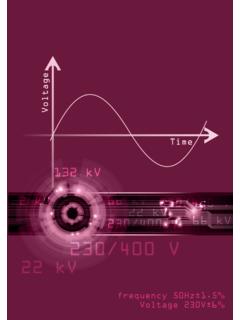Transcription of Electric Power Transfer Capability: Concepts, …
1 Electric Power Transfer Capability: Concepts, applications , sensitivity , UncertaintyPower Systems Engineering Research CenterA National Science FoundationIndustry/University Cooperative Research Centersince 1996 PSERCELECTRICPOWERTRANSFERCAPABILITY:CON CEPTS, applications ,SENSITIVITYANDUNCERTA INTYIan DobsonUniversity of Wisconsin-MadisonScott Greene and Rajesh RajaramanLaurits R. Christensen AssociatesChristopher L. DeMarco, Fernando L. Alvarado,Mevludin Glavic and Jianfeng ZhangUniversity of Wisconsin-MadisonRay ZimmermanCornell UniversityPowerSystems Engineering Research CenterPSERC Publication 01-34 November Report and project informationInformation about this ProjectProject information can be obtained by contacting:Ian DobsonRajesh RajaramanProfessorSenior EngineerElectrical &Computer Engineering Laurits R. Christensen AssociatesUniversity of Wisconsin-Madison 4610 University Avenue, Suite 7001415 Engineering DriveMadison WI 53705 Madison WI 53706 USAphone : (608) 231-1398 ext 191phone: 608-262-2661email 608-262-1267email: Copies of the ReportThis report appears electronically at and is alsoavailable from thePowerSystems Engineering Research Center website, The PSERC publication number is 01-34.
2 For addi-tional information, contact: Power Systems Engineering Research CenterCornell University428 Phillips HallIthaca, New York 14853 Phone: 607-255-5601 Fax: 607-255-8871 Notice Concerning Copyright MaterialPermission to copy without fee all or part of this publication is granted if appropriateattribution is given to this document as the source 2001 Board of Regents of the University of Wisconsin. All rights AcknowledgementsThis report was produced by collaboration between the Power Systems EngineeringResearch Center and Laurits R. Christensen Associates as part of a project fundedby the National Science Foundation Research Centers - Small Firms CollaborativeR&D Initiative under NSF Award numbers 9815325 and 9815678. We gratefullyacknowledge this support from the National Science Foundation. We also thank thePowerSystems Engineering Research Center for its support in making this opinions, findings, and conclusions or recommendations expressed in this mate-rial are those of the authors and do not necessarily reflect the views of the NationalScience Summary.
3 General motivation .. A simplified Transfer capability calculation .. AC load flow example using calculator .. Getting started on the calculator .. Quickly computing changes to Transfer capability .. Transfer capability depends on assumptions .. Interactions between transfers .. 6 bus system .. 39 bus system .. NYISO 3357 bus system .. Concluding comments .. DC load flow example .. 92 Transfer Purpose of Transfer capability computations .. Transfer capability and Power system security .. Transfer capability and market forecasting .. Transfer capability and electricity markets .. Bilateral markets .. Overview of Transfer capability computation .. Generic Transfer capability .. Continuation methods .. Optimal Power flow approaches .. Linear methods .. 22 3 sensitivity of Transfer Explanations of sensitivity .. Sensitivities in DC load flow .. Estimating interactions between transfers .. Fast formula for sensitivity and 3357 bus example.
4 28i4 Available Transfer capability .. The economics of Power markets and the Poolco model .. Nodal prices/Poolco .. Planning .. Market redispatch .. Summary of paper by Corniere et al.. Background survey of security and optimization .. 355 Quantifying transmission reliability Quantifying TRM with a formula .. Sources of uncertainty .. Simulation test results .. Probabilistic Transfer capacity .. Conclusions .. 446 uncertainty , probabilistic modeling and Temperature uncertainty and load response modeling .. Sample calculation in IEEE 39 bus system .. Extensions to flowgates and general random injection variation .. Background on probability distributions .. Probability of transmission congestion in flowgates .. Numerical Example .. Maximizing probabilistic Power transfers .. Numerical Example .. Stochastic optimal Power flow .. 63 References677 Reprints of references [1] and [2]75iiChapter SummaryTransfer of bulk electrical Power over long distances is routine in North Americain order to have a reliable and economical electrical supply.
5 For example, hydro- Electric Power generated in Canada can be transferred to consumers and industryin Los Angeles using the high voltage transmission system. But the transmissionsystem has a limited capability to Transfer Power . The maximum Power that can betransferred is called the Transfer capability . To operate the Power system safely andto gain the benefits of the bulk Power transfers, the Transfer capabilities must becalculated and the Power system planned and operated so that the Power transfersdo not exceed the Transfer purpose of this document is to explain concepts and calculations of trans-fer capability and describe applications of Transfer capability . The document aimsto give a tutorial introduction to some standard Transfer capability concepts andintroduce some new methods in Transfer capability sensitivity and accounting highlights of the document are:1. Explanation and illustration of Transfer capability using a Transfer capabilitycalculator available on the web (chapter 1).
6 2. Discussion of Transfer capability computations and applications (chapters 2and 4).3. Fast methods to compute Transfer capability sensitivities to a wide range ofparameters using formulas; testing of these methods on a 3357 bus system(chapter 3).4. Extension of standard DC load flow Transfer capability methods to AC loadflow models and parameters (chapter 3).5. New method of quantifying uncertainty in Transfer capability computations(chapters 5 and 6).16. Accounting for uncertainty in key parameters ( , forecast temperature) intransfer capability computations (chapter 6).7. Maximizing transfers subject to a given risk of flowgate congestion due touncertainty (chapter 6).8. Estimate probability of transmission congestion in any flowgate (chapter 6). General motivationLong distance bulk Power transfers are essential for an economic and secure supplyof Electric Power in North Transfer capability indicates how much interarea Power transferscan be increased without compromising system security.
7 Accurate identification ofthis capability provides vital information for both planning and operation of thebulk Power market. (Planners need to know the system bottlenecks and systemoperators must not implement transfers which exceed the calculated Transfer capa-bility.) Repeated estimates of Transfer capabilities are needed to ensure that thecombined effects of Power transfers do not cause an undue risk of system overloads,equipment damage, or blackouts. However, an overly conservative estimate of trans-fer capability unnecessarily limits the Power transfers and is a costly and inefficientuse of the network. Power transfers are increasing both in amount and in variety asderegulation proceeds. Indeed, such Power transfers are necessary for a competitivemarket for Electric Power . There is a very strong economic incentive to improvethe accuracy and effectiveness of Transfer capability computations for use by systemoperators, planners and Power practical computations of Transfer capability are evolving.
8 The compu-tations presently being implemented are usually oversimplified and in many casesdo not take sufficient account of effects such as interactions between Power trans-fers, loop flows, nonlinearities, operating policies, and voltage collapse goal of the methods described here is to improve the accuracy and realism oftransfer capability computations. The Power system must be operated with someconservatism to account for the effects of uncertainty in Power system data. Thisuncertainty can be analyzed and quantified to provide a defensible basis for limitations on Power system performance that we consider in this documentare transmission line flow limits, voltage magnitudes and voltage collapse. All theselimits can be handled in an AC load flow Power system model. We do not addresslimits due to transient stability or oscillations; in our framework, these limits haveto be crudely approximated by flow A simplified Transfer capability calculationOne way to explain Transfer capability is to work top-down from the purpose oftransfer capability by discussing definitions and meanings of various components2of Transfer capability and then explaining the various methods for calculating eachcomponent.
9 This useful approach is followed, for example, by NERC in definingtransfer capability [89], [90]. In this tutorial, we take an alternative approach ofexplaining how to calculate Transfer capability in a simplified case and then general-izing the calculation. We think that a focus on what one typically calculates tendsto reveal the meanings and limitations of Transfer capability section introduces and explains Transfer capability in a simplified transmission network is assumed to be fixed so that, if any contingencies suchas a line outage are considered, they are incorporated into the network and do notchange during the discussion. Only one Transfer capability calculation is explained;in practice the calculation is repeated with a range of assumptions. The modelingis assumed to be deterministic; probabilistic effects are neglected. A more detailedexplanation of Transfer capability is in Chapter are many assumptions or choices made during a Transfer capability cal-culation which can greatly influence the answer.
10 In addition to choices made inmodeling the Power system, the base case, the Transfer itself, and the limiting casemust all be chosen. These choices are now Case: The base case is an assumed Power system operating condition towhich the Transfer is applied. That is, the base case is the assumed Power systemoperating condition when no Power has been transferred. A Power system operatingcondition is generally obtained by specifying the powers generated or consumedat each bus and the control settings and then solving Power system equations tocalculate the other Power system quantities such as Power flows on the transmissionlines. The base case is assumed to be an operating condition solved in this wayand also a secure condition so that all quantities such as line flows and bus voltagemagnitudes lie within their operating the Transfer : A Transfer is specified by changes in Power injectionsat buses in the network. For example, a point to point Transfer from bus A to bus Bis specified by increasing Power at bus A and reducing Power at bus B.
